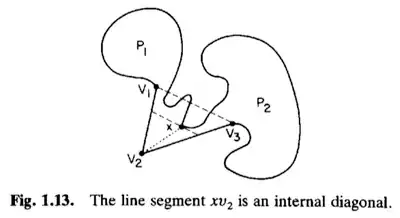I will just attend to the question of inside/outside. It follows from the Jordan Curve Theorem that your polygon splits the plane into two parts, an inside and an (unbounded) outside. To get from one to the other, we insist on smooth curves (or, for that matter, polygonal paths) that cross the polygon only once, not at a vertex, and at a nonzero angle to the segment crossed (tangency not allowed).
As a result, the simple test for inside/outside, for extremely convoluted figures, is to start a some point very far from the polygon, draw a path to the point of interest, and count the number of times the path crosses the polygon (permitting only the types of crossing indicated above). If the number of crossings is $0$ or otherwise even, the point of interest is outside the polygon. If the number of crossings is $1$ or otherwise odd, the point of interest is inside the polygon.
EDIT **** SATURDAY: A very good proof and discussion is given by Joseph O'Rourke, website OROURKE in Chapter One of his book Art Gallery Theorems and Algorithms, which one may download as separate chapters. In Chapter One, "Polygon Partitions," page 12, there is a quick proof for your question, as part of Theorem 1.2. Take three consecutive vertices $v_1, v_2, v_3$ such that the angle is "convex" with regard to the polygon $P$, that is, a tiny neighborhood of $v_2$ inside the angle $v_1 v_2 v_3$ (demanded below $\pi$) is also inside the polygon $P.$

Perhaps $v_1 v_3$ is a line segment completely contained in $P,$ in which case we are done. If not, it means there are other vertices of the original polygon inside the triangle with vertices $v_1, v_2, v_3.$ Find the vertex, call it $x,$ that is inside the triangle and is closest to $v_2,$ distance measured only in the direction perpendicular to segment $v_1 v_3$ (see Figure 1.13). As a result, the line through $x$ and parallel to $v_1 v_3$ can not intersect any other edges of $P$ inside the triangle $v_1 v_2 v_3.$ Then the segment $v_2 x$ is completely inside $P.$ . Note that measuring distance for $x$ by full Euclidean distance may not work properly here. Draw some pictures! On page 13, he mentions Meister's Two Ears Theorem (1975), Theorem 1.3, which is probably the item you saw quoted.
Evidently Meister is G. Meister, "Polygons have ears," American Mathematical Monthly, volume 82, pages 648-651, 1975.
O'Rourke:
https://math.stackexchange.com/users/237/joseph-orourke
https://mathoverflow.net/users/6094/joseph-orourke
